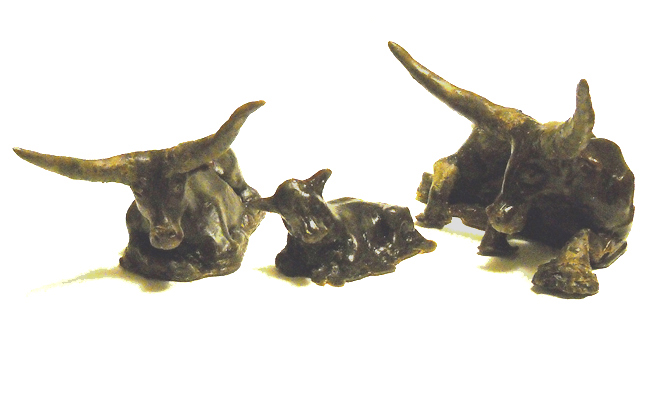Bronze Casting - The Wax Models

The wax models are made from a mold created from the original clay sculptures. So after you make the mold, you pour in the wax, let it cool, and you get a wax cast of the original. There are a number of details about mold making - not the least some health precausions - that make it advisable to get professional instruction.
In the olden days, it was common to create rigid plaster "piece molds". That is you would create a mold in many pieces of plaster that would fit together snugly but were constructed to avoid locking the mold onto the statue due to irregularities in the surface (called undercuts). Making a piece mold of this sculpture would have been extremely time consuming, difficult, and is the reason why master sculptures like Verrochio had assistants. For what it's worth, Rodin - known for his bronze sculptures - never cast a statue himself. He hired - yes, he hired - a foundry to do the work for him.
The alternative to a piece mold is to make a flexible "inner" mold surrounded by a rigid (usually plaster) "mother mold". Again in the olden days you could make flexible molds and they were made of gelatin. Gelatin, though, is a weak material that tears easily and dries out and loses its shape quickly. Rarely is it used in making modern wax models.
Modern flexible molds are inevitably made of rubber. There are a number of techniques to make the mold, probably the most common is to brush on the liquid rubber that cures over the space of an hour or so. Silicone rubbers, latex, and urethanes rubbers are all used and have their advantages and disadvantages. Whatever the material, you build up several layers so it will be thick enough not to tear but thin enough to peel away. Usually - but not necessarily always - the rubber mold is either made in two or more sections - so in some ways is a piece mold - and peeled away. Needless to say, a mold release - a substance usually sprayed on the original models to prevent the rubber from sticking - is absolutely necessary.
Once the rubber has been peeled away, it is then fit back over the original model to verify it reproduces the shape well and hold it in place. Next the mother mold is made by coating the rubber mold and interior model with plaster. This also is straightforward in principle but there are important details that again make professional instruction advisable. For one thing you have to construct "keys" so the parts of the molds will fit snugly and not leak when you pour in the wax.
When the mother mold - like the inner mold, usually constructed in at least halves if not in more pieces - is completed, the inner rubber mold is fit snugly inside. So what you then have is a rigid mold which has a rubber inner lining, and so a mold that captures details better than a completely rigid mold.
The wax casts shown were cast solid. The molds were simply inverted, held in place by clamps, and the wax poured in and allowed to fully solidify (once more - mold release is needed unless you want to destroy the wax cast).
Usually, though, except for quite small sculptures, you normally make a hollow wax cast. For these models it probably would have been better to make hollow models. To make a hollow model, you pour the wax in the mold, slosh it around thoroughly coating the inside, and then pour the excess wax out (but don't throw it away). So you end up with a thin layer of wax that coats the inside of the mold. After the wax layer solidifies, you pour in some more wax - but which is also slowly cooling and gradually thickening - and again slosh the wax around and pour it out. You repeat the sloshing and pouring until you get a wax layer built up to about 3/16 of an inch, which is usually sufficient for most bronze statues. When you remove the wax models from the molds, you then have to check for thin areas (holding the model up to a light) and add what is necessary to make the wax thick enough to make a nice bronze cast, but thick enough not to be too heavy
The outcome - if successful - is a wax replica of the original clay model. Lamentably, is also not uncommon that the original clay models - particularly of complex sculptures - get broken during the mold making, or as in this case, that parts of the models must be cut apart - the horns were removed before making the mold - and assembled later. But once you have a rubber mold, you can make a new model for making new molds. Traditionally these "master" molds are plaster, but now they are often cast in a polymer resin or plastic which are durable and less brittle. A good rubber mold can last for years and produce many replicates.
Again there are many details - some related to technique, others to health concerns - that mandate mold making and wax casting not be tried at home, not at least at first.